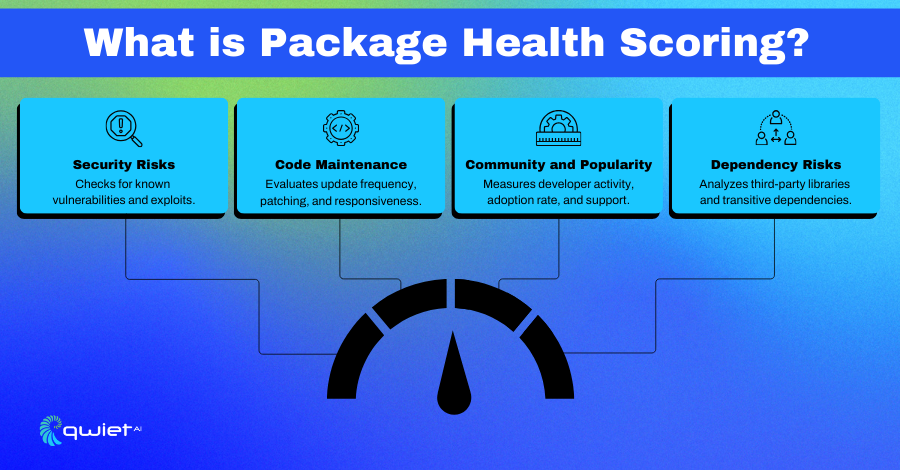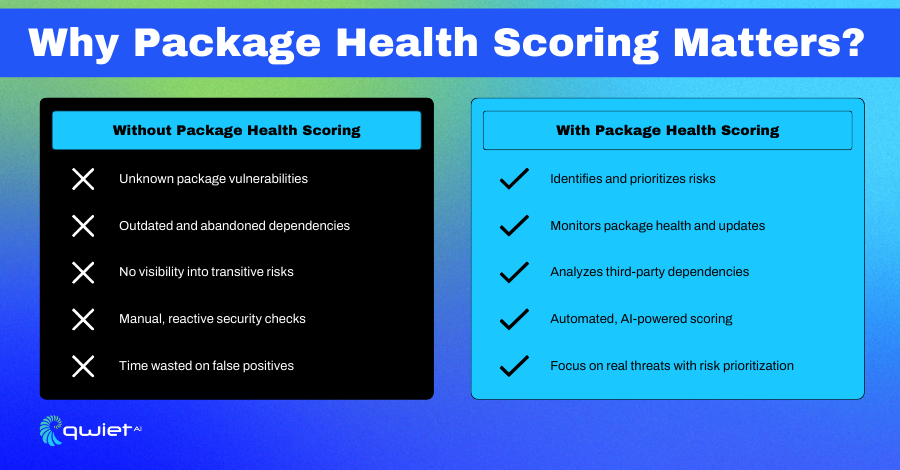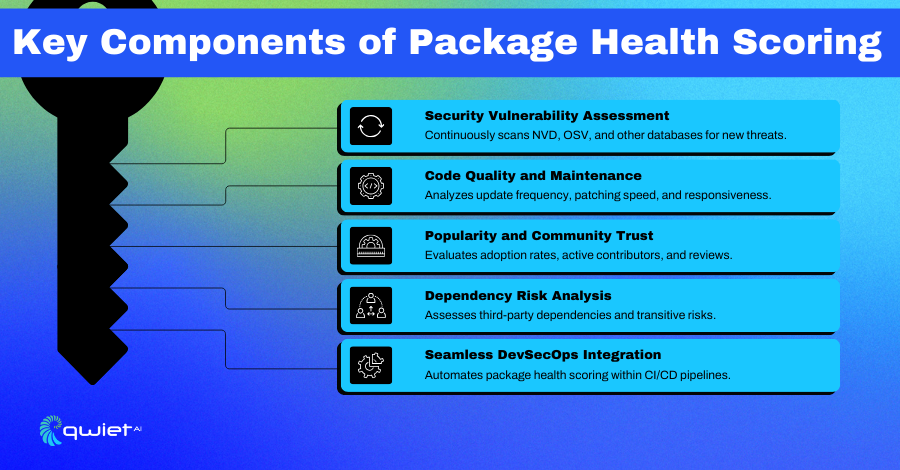Key Takeaways
- Proactive Security: Package health scoring helps identify vulnerabilities and risks in software dependencies.
- Beyond Vulnerabilities: Evaluates multiple factors, including security, maintenance, and popularity.
- Automated and Scalable: Enables efficient risk assessment without manual intervention.
What is Package Health Scoring?

Package health scoring helps developers and security teams understand the overall quality and security of the software packages they rely on. It looks beyond known vulnerabilities, factoring in update frequency, developer responsiveness, and how widely a package is used. Traditional vulnerability scans only catch issues that have already been reported, but this approach helps spot risks earlier—before they turn into bigger problems.
With so many third-party dependencies in modern applications, it’s easy to overlook outdated or poorly maintained packages. A package that isn’t actively updated can quickly become a security risk, and relying on an abandoned project could cause serious headaches. Package health scoring gives you a clearer picture of what’s safe to use and what might introduce hidden risks so you can make smarter decisions about the software you build with.
Why Does Package Health Scoring Matter?

Security
Security vulnerabilities in software dependencies can create serious risks if they go unnoticed. Package health scoring helps catch these issues early by tracking security flaws before they become production. It also monitors package updates and newly discovered threats so teams aren’t relying on outdated or compromised dependencies. Traditional vulnerability scans don’t always catch everything, but package health scoring protects by flagging risky or neglected packages before they become problematic.
Operational Benefits
Too many security tools flag every possible issue, leaving teams with false positives. Package health scoring helps cut through the noise by focusing on real risks, making it easier to decide which updates need attention first. Instead of blindly applying patches, teams can prioritize updates based on security impact and maintenance history. When integrated into CI/CD pipelines, package health scoring runs automatically in the background, keeping security checks streamlined without slowing development.
Compliance and Governance
Maintaining security and licensing requirements is challenging, especially with constantly evolving regulations like NIST, ISO 27001, and SOC 2. Package health scoring makes it easier to stay compliant by generating audit-ready reports documenting security risks and package maintenance history. It also helps flag potential licensing conflicts so teams don’t accidentally use open-source packages with restrictions that could cause legal issues later.
Key Components of Package Health Scoring

Security Vulnerability Assessment
Software package security threats change constantly, so keeping up with them means constant monitoring. Package health scoring checks vulnerability databases like NVD and OSV in real-time, flagging security risks as they emerge. It also helps teams prioritize vulnerabilities based on severity to determine which issues need immediate attention. Instead of sorting through endless alerts, teams can focus on fixing what matters.
Code Quality and Maintenance Metrics
A package that isn’t actively maintained can quickly become a security risk. Package health scoring examines update history, how quickly security patches are applied, and whether developers support the project. If a package hasn’t been updated in a long time or the maintainers aren’t responding to issues, that’s a sign it might be better to find an alternative before it causes problems down the road.
Popularity and Community Trust
The more widely used a package is, the more likely it is to be well-maintained. Package health scoring considers things like download numbers, adoption trends, and the activeness of the developer community. A package with many contributors and regular updates is generally a safer bet than one seeing little activity. If a package loses traction, it could be a sign that it won’t be supported much longer.
Dependency Risk Analysis
Every package has its own dependencies, which can introduce hidden security risks. Package health scoring looks at the full dependency chain to see if any underlying libraries are outdated, vulnerable, or poorly maintained. A package might look fine on the surface, but it could still put an application at risk if built on insecure components.
Seamless DevSecOps Integration
Security shouldn’t slow development down. Package health scoring works within CI/CD pipelines, automatically checking dependencies in the background so teams don’t have to stop what they’re doing. It provides clear, actionable guidance when it finds issues, so developers know exactly what needs to be fixed without wasting time digging through reports.
Conclusion
Traditional vulnerability scanning only catches known security issues, but that’s not enough to manage the risks that come with software dependencies. Package health scoring takes a broader approach, evaluating security, maintenance, and overall reliability to give teams a clearer picture of the risks they’re dealing with. With the right insights, teams can take a proactive approach to security, streamline compliance, and improve the stability of their software supply chain. Instead of reacting to problems after they surface, package health scoring helps catch issues early and make informed decisions about the dependencies being used. Want to see how this works in action? Book a demo with Qwiet AI today.
FAQ
What is package health scoring?
It’s a way to assess the security and reliability of software packages beyond just scanning for known vulnerabilities. It looks at how often a package is updated, whether it’s actively maintained, and whether it has risky dependencies, giving you a full picture of whether it’s safe to use.
How is package health scoring different from vulnerability scanning?
Vulnerability scanning only looks for reported security flaws, but that’s just one part of the risk. Package health scoring takes a step further by checking if a package is well-maintained, has a strong community behind it, and is actively updated. This helps spot potential issues before they turn into real problems.
Can package health scoring be integrated into DevSecOps?
Yes! It works directly within CI/CD pipelines, so security checks happen automatically without slowing development. Developers get real-time insights, so they know exactly which dependencies need attention.
Read Next
The Autonomous AppSec Journey
Introduction As AI and automation reshape industries, application security (AppSec) rapidly evolves from systems that support analysts to those that can function independently. This post walks you through the stages of autonomous AppSec, showing how AI-driven systems change how security is managed. You’ll discover how the technology works at each level of automation and what […]
Vulnerability Assessment Overview
What is a Vulnerability Assessment? A vulnerability assessment is a thorough check-up of your information systems to find any security weaknesses. This involves identifying, classifying, and prioritizing potential vulnerabilities in your computer systems, networks, and communication channels. The goal is to uncover any weak spots that might be targeted by cyber threats so you can […]
Secret Management in Application Security: Protecting Sen...
Key Takeaways Secure secret management prevents data leaks and unauthorized access by protecting API keys, database credentials, and encryption keys from exposure. Automated secret management tools improve security and efficiency by enforcing access controls, secret rotation, and real-time monitoring. AI-driven detection and Code Property Graph (CPG) analysis enhance secret security by identifying hardcoded secrets and […]